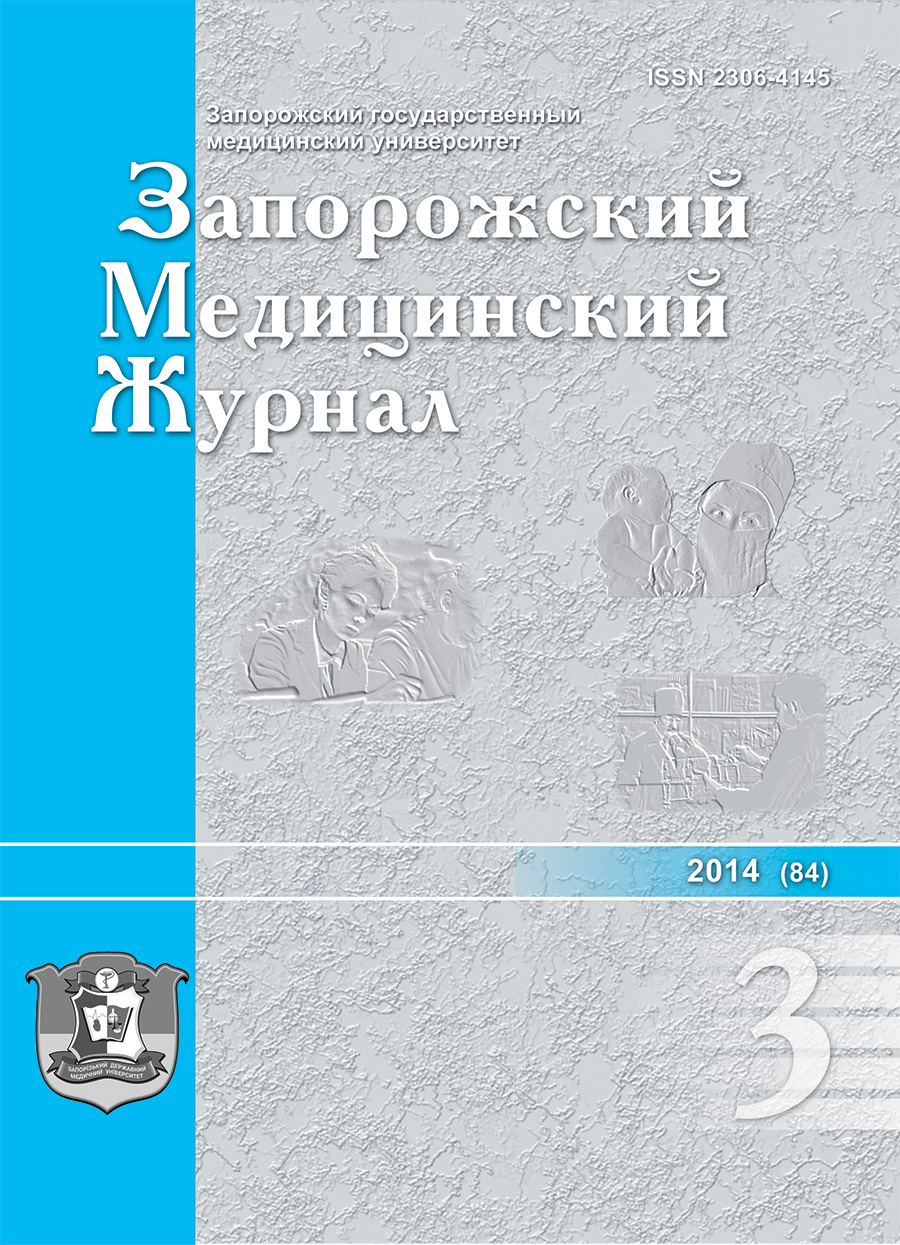Phenotypical features and states of the vegetative nervous system in patients with aneurism of ascending part of aorta
DOI:
https://doi.org/10.14739/2310-1210.2014.3.25695Keywords:
Heart Aneurism, Ascending Aorta, Risk Factors, Connective Tissue Diseases, Myokardial Ishemia, HypertensionAbstract
Aim. Phenotypic features and vegetative balance in patients of all ages with an aneurysm of ascending aorta.
Methods and results. In order to identify the underlying causes and associated factors in the development of ascending aorta aneurysm in patients of different age and its complications predictors, there were 154 patients examined for the phenotypic characteristics and the research conducted by the methods of echocardiography, ECG, ambulatory monitoring of ECG and blood pressure.
Conclusion. There were irregularities of autonomic balance, mainly hypersympathicotonia. Patients of young and middle age had dystonia associated with connective tissue disorder. In older patients autonomic balance changes were associated with left ventricular hypertrophy and reduced contractile function of the heart. This suggests the possibility of using this combination of abnormalities in the evaluation of development of the aneurysm.
References
Konstantinov, B. A., Belov, Yu. V., Kuznechevskij, F. V. (2006). Anevrizmy voskhodyaschego otdela i dugi aorty [Aneurysm of the ascending aorta and arch aorta]. Moscow. [in Russian].
Keane, M. G., & Pyeritz, R. E. (2008). Medical Management of Marfan Syndrome. Circulation, 117(21), 2802–2813.
Zerbino, D. D., Kuzyk, Yu. I. (2002). Rasslaivayushhie anevrizmy aorty: klinicheskie maski, osobennosti differencial'noj diagnostiki [Dissecting aortic aneurysm: clinical masks, especially the differential diagnosis]. Klinicheskaya medicina, 5, 58–61. [in Russian].
Osovska, N. Yu., Kavatsiuk, O. O. (2010). Chynnyky vynyknennia anevryzmy vyskhidnoho viddilu aorty u molodykh liudej [Factors of aneurysms of the ascending aorta in young people]. Proceedings of the 11th National Congress of Ukraine. (p. 205). Kyiv [in Ukrainian].
Grahame, R, Bird, H. A., Child, A., et al. (2000). The British Society for Rheumatology Special Interest Group on Heritable Disorders of Connective Tissue Criteria for the Benign Joint Hypermobility Syndrome. The Revised (Brighton 1998) Criteria for the Diagnosis of the BJHS. J Rheumatol, 27, 1777–1779.
Rebrova, O. Yu. (2006). Statisticheskij analiz medicinskikh dannykh. Primenenie paketa prikladnikh programm STATISTICA [Statistical analysis of medical data. Application application packages STATISTICA]. Moscow. [in Russian].
Antomonov, M. Yu. (2004). Raschet porogovykh (kriticheskikh) urovnej dejstvuyushhikh uchetnykh faktorov dlya razlichnogo tipa dannykh, poluchennykh v gigienicheskikh issledovaniyakh [Payment Threshold (critical) levels acting factors account in four different types data from studies hygiene]. Gigiena naselennykh punktov, 43, 573–579. [in Russian].
Inzel, T. N., Gagloeva, L. M., Kovalskij, S. V. (2000). Diagnosticheskoe znachenie specificheskikh genotipicheskikh markerov anomalij razvitiya pochek, associirovannykh s sindromom displazii soedinitel'noj tkani [Diagnostic value of specific genotypic markers of renal malformations associated with connective tissue dysplasia syndrome]. Urologiya, 3, 8–9. [in Ukrainian].
Bondarenko, I. P. (2004). Malye anomalii serdca v diagnostike vrozhdennoj displazi i soedinitel'noj tkani [Small heart abnormalities in the diagnosis of congenital connective tissue dysplasia]. Ukrainskyi kardiolohichnyi. zhurnal, 3, 66–69. [in Ukrainian].
Osovska, N. Yu. (2007). Vehetatyvni ta psykhonevrolohichni osoblyvosti u khvorykh z kardialnymy proiavamy syndromu dysplazii spoluchnoi tkanyny [Vegetative and neuropsychiatric features in patients with cardiac syndrome manifestations of connective tissue dysplasia]. Ukrainskyi terapevtychnyi zhurnal, 3, 43–46. [in Ukrainian].
Downloads
How to Cite
Issue
Section
License
Authors who publish with this journal agree to the following terms:
Authors retain copyright and grant the journal right of first publication with the work simultaneously licensed under a Creative Commons Attribution License that allows others to share the work with an acknowledgement of the work's authorship and initial publication in this journal. 

